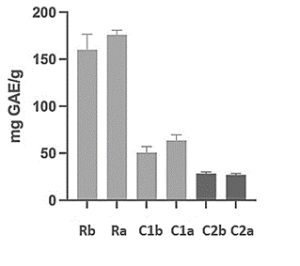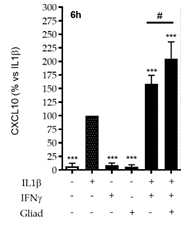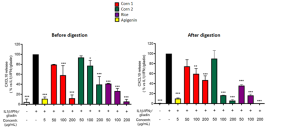closed
Francesca Colombo, University of Milan, Italy
3-years Project
Celiac disease
Area: Inflammation
Grant: 004/2019
- Title: Naturally gluten free pigmented cereals to modulate the anti-inflammatory status in celiac disease.
- Duration: Triennial Project
- Principal Investigator: Francesca Colombo, University of Milan, Italy
- Tutor (Head Lab): Prof. Patrizia Restani, University of Milan, Italy
Publications originating from the Project
- Corinne Bani, Carola Cappa, Patrizia Restani, Marianna Sala, Francesca Colombo, Francesca Mercogliano, Chiara Di Lorenzo, Physicochemical and nutritional quality of pigmented rice and bran: influence of milling and cooking, LWT, 2024, 116653, ISSN 0023-6438, https://doi.org/10.1016/j.lwt.2024.116653.
- Colombo F, Di Lorenzo C, Petroni K, Silano M, Pilu R, Falletta E, Biella S, Restani P. Pigmented Corn Varieties as Functional Ingredients for Gluten-Free Products. Foods. 2021 Jul 30;10(8):1770. doi: 10.3390/foods10081770. PMID: 34441547; PMCID: PMC8392392. https://pubmed.ncbi.nlm.nih.gov/34441547/
- Piazza S, Colombo F, Bani C, Fumagalli M, Vincentini O, Sangiovanni E, Martinelli G, Biella S, Silano M, Restani P, Dell’Agli M, Di Lorenzo C. Evaluation of the Potential Anti-Inflammatory Activity of Black Rice in the Framework of Celiac Disease. Foods. 2022 Dec 22;12(1):63. doi: 10.3390/foods12010063. PMID: 36613279; PMCID: PMC9818972. https://pubmed.ncbi.nlm.nih.gov/36613279/
- Bani C, Di Lorenzo C, Restani P, Mercogliano F, Colombo F. Phenolic Profile and In Vitro Antioxidant Activity of Different Corn and Rice Varieties. Plants (Basel). 2023 Jan 18;12(3):448. doi: 10.3390/plants12030448. PMID: 36771533; PMCID: PMC9920881. https://pubmed.ncbi.nlm.nih.gov/36771533/
- Colombo F, Cappa C, Bani C, Magni M, Biella S, Restani P, Di Lorenzo C. Characterization of color, phenolic profile, and antioxidant activity of Italian pigmented rice varieties after different technological treatments. Food Bioscience. 2023. https://doi.org/10.1016/j.fbio.2023.102674
THE STUDY
Project rationale and aims
Celiac disease (CD) is an immune-mediate disorder, triggered in genetically susceptible individuals by prolamins present in some cereals (e.g. gliadin from wheat). Gliadin in celiac patients determines cytotoxic or immunomodulatory activity, and some gliadin regions are responsible for the oxidative stress. In particular, the gliadin peptides penetrate the cells inducing the production of pro-inflammatory cytokines and enzymes, such as inducible nitric oxide synthase (iNOS), associated with the production of nitric oxide (NO) that induces oxidative stress. Oxidative imbalance appears to be one of the pathogenetic mechanisms involved in CD and some studies suggest that the gluten-free diet only partially reduces the oxidative stress at intestinal level.
Several dietary components have antioxidant properties and could have a positive role in protecting the intestinal epithelium; therefore, their consumption could modulate the toxicity of gliadin peptides in celiac patients. Among plants, also cereals, and in particular the pigmented varieties, contain several polyphenols with well-known antioxidant and anti-inflammatory properties. The aim of this project was the study of specific naturally gluten-free cereals (rice and corn) characterized by potential healthy properties. To achieve this aims different pigmented varieties of rice and corn, rich in anthocyanins, were selected and chemically characterized. Subsequently, they were in vitro digested and tested for their activity in modulating the early gliadin-dependent events at cellular level.
Research plan and results obtained
In the first task of the Project, gluten free rice and corn with different pigmentation were chemically characterized. Some of them (the most promising) were digested in vitro and studied using specific cellular models for their antioxidant and anti-inflammatory activities, and their role in modulating the early gliadin-dependent events. Corn and rice varieties with different pigmentation were initially screened and characterized for their phenolic content (PC). Generally speaking, the pigmented varieties (particularly the samples rich in anthocyanins) showed a higher PC compared to the non-pigmented ones. For all samples the phenotypes with the highest PC showed also the highest antioxidant capacity. The most promising varieties were extracted, in vitro digested, and tested by a cellular in vitro model, which has been developed to mimic a celiac-like inflammatory status. Although the in vitro digestion significantly affected the anthocyanin concentration, no important differences were observed in term of PC, suggesting the transformation of anthocyanin in other active molecules (e.g. phenolic acids) (Fig 1).

Figure 1 – Phenolic content in some pigmented rice (R) and corn (C) extracts before (b) and after (a) in vitro digestion. Results are expressed as mg equivalent of gallic acid/g (mg GAE/g).
To evaluate the anti-inflammatory activity of pigmented varieties at intestinal level, CaCo-2 cells were treated with gliadin alone or in combination with cytokines known for their involvement in autoimmune diseases (IL-1β and IFN-γ). The stimulation of CaCo-2 with gliadin, in combination with IL-1β and IFN-γ, determined a significant additional effect on the release of inflammatory mediators (e.g. CXCL8 and CXCL10), confirming the role of this prolamin in the modulation of epithelial-driven inflammation (Fig 2).

Figure 2 – Effect of IL-1β (10 ng/mL), IFN-γ (10 ng/mL) and in vitro digested gliadin (1 mg/mL) on CXCL10 release, measured in CaCo-2 cells stimulated for 6 h. ***p<0.001 vs IL-1β, #p < 0.05 vs IL-1β/IFN-γ.
The extracts from pigmented cereals, tested in the in vitro model, caused a reduction in the release of different pro-inflammatory mediators (e.g., CXCL10, ICAM-1), both before and after digestion (Fig 3). Moreover, the ability of these extracts to reduce the ROS level induced by digested gliadin was confirmed by another specific in vitro test.

Figure 3 – Effects of pigmented corn and rice extracts on the release of CXCL10 before and after in vitro digestion. *p<0.05, **p<0.01; ***p<0.001.
Experimental design and methodologies
The phenolic profile and the antioxidant activity of cereals was qualitatively and quantitatively evaluated, both before and after in vitro digestion, applying different spectrophotometric and chromatographic techniques (HPTLC and HPLC-DAD). For the cellular tests, samples were extracted using an optimized hydro-alcoholic solution. For the determination of anti-inflammatory activity, CaCo-2 cells were treated with proinflammatory cytokines (IL-1β and IFN-γ, 10 ng/mL) in combination with gliadin after its digestion performed in vitro (1 mg/mL) and the pigmented extracts (50-200 µg/mL). All the inflammatory mediators (e.g. CXCL8 and CXCL10) were measured after 6h of induction, by using ELISA assays. In addition, the ability of extracts to reduce the ROS level in CaCo-2 cells after the treatment with digested gliadin was evaluated.
Potential pitfalls and caveats
A potential limitation of this study is related to the difficulty in the reproduction of the complex in vivo inflammatory process, which involves many cellular actors, but the results obtained are useful information to better understanding the mechanisms responsible for the pro-inflammatory action of gliadin. The cereals included in the diet could be subjected to different variables (e.g., technological treatments, digestion) capable to influence the stability and activity of the bioactive compounds. For these reasons, during the Project some of these factors, such as the digestion, were considered and tested.
Conclusions and discussion
The important role of oxidative stress and inflammation in celiac disease has been reported by recent studies. Foods rich in antioxidant compounds could represent an interesting tool to counteract and prevent the alterations at intestinal level, characteristic of celiac subjects. Rice and corn represent the most consumed gluten-free cereals and, as confirmed in the present Project, the pigmented varieties are richer in bioactive compounds (such as anthocyanins and flavonoids) with antioxidant activity when compared to the non-pigmented counterpart. In this study, a specific cellular model in CaCo-2 cells, based on the use of gliadin as pro-inflammatory stimulus, was developed, allowing to better elucidate the role of gliadin in the modulation of epithelial-driven inflammation. The experiments underlined the potential anti-inflammatory activity of extracts from pigmented cereals (both rice and corn) at intestinal level, with particular attention to lymphocytes-attracting CXCL-10. In particular, black rice extracts showed significant inhibitory effect on CXCL-10 release at concentrations plausibly achievable after oral consumption. The biological activity was preserved during the gastrointestinal digestion, and we suppose that this could be explain by the presence of anthocyanins and their digestion metabolites (such as phenolic acid).
The results obtained in this project could be useful to partially clarify the possible role of dietary phenolic compounds in the protection of intestinal mucosa from the damage due to gliadin and other toxic prolamins. Moreover, the results obtained could promote the use of pigmented cereals among celiac subjects, improving their quality of life.
Although the data obtained in this study need further evidence by dietary intervention approaches, this research has defined a solid base for future investigations on the use pigmented cereals in the formulation of gluten-free food or food supplements.
